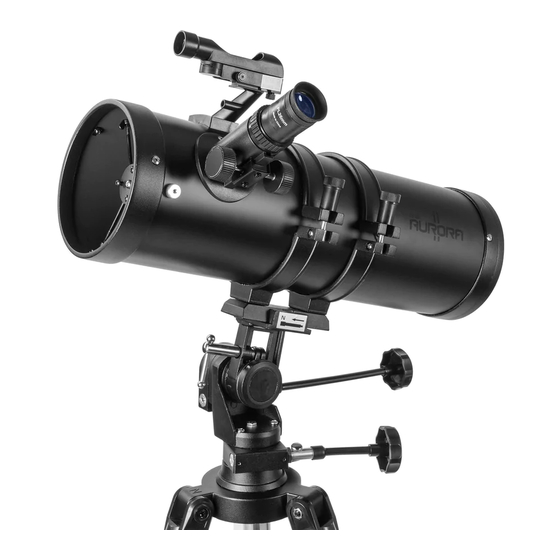Advertisement
Quick Links
AURORA II
Flat Black 114mm Telescope w/
Slow Motion AZ Mount
Instruction Manual
Aurora II Telescope Specifications
Optical Design
Magnification
Front Lens (clear aperture)
Focal Length
Standard Eyepieces
Finish
Tripod
WARNING:
SUN HAZARD — Never look directly at the sun
with this device.
Slow Motion Alt-Azimuth Mount
WARNING:
CHOKING HAZARD — Small parts.
Not for children under 3 years.
1
Newtonian Reflector
20-52x
114mm
500mm
Plossl 26mm & 9.7mm
Flat Black
1
X
CR2032
3V
INCLUDED
WARNING:
Contains button or coin cell battery.
Hazardous if swallowed — see instructions.
10
+
88-20114
Advertisement

Summary of Contents for Explore One Aurora II
- Page 1 88-20114 AURORA II Flat Black 114mm Telescope w/ Slow Motion AZ Mount Instruction Manual Aurora II Telescope Specifications Optical Design Newtonian Reflector Magnification 20-52x Front Lens (clear aperture) 114mm Focal Length 500mm Standard Eyepieces Plossl 26mm & 9.7mm Finish Flat Black...
- Page 2 SUN WARNING WARNING: NEVER ATTEMPT TO OBSERVE THE SUN WITH THIS DEVICE! OBSERVING THE SUN – EVEN FOR A MOMENT – WILL CAUSE INSTANT AND IRREVERSIBLE DAMAGE TO YOUR EYE OR EVEN BLINDNESS. Eye damage is often painless, so there is no warning to the observer that the damage has occurred until it is too late.
-
Page 3: Parts Overview
Parts Overview 1. 114mm Telescope Optics 2. Red Dot ViewFinder 3. Focuser 4. Flexible Shaft (Altitude Up and Down) 5. Flexible Shaft (Azimuth Left and Right) 6. 26mm & 9.7mm Plossl Eyepieces 7. Tripod 8. Tripod Accessory Tray... - Page 4 How To Set Up Assembly: Note: We recommend assembling your telescope for the first time in the daylight or in a lit room so that you can familiarize yourself with assembly steps and all components. 1. General Information regarding Assembly, Positioning Before beginning with the assembly, choose a suitable position for your telescope.
- Page 5 Telescope Terms To Know: Diagonal: A mirror that deflects the ray of light 90 degrees. With a horizontal telescope tube, this device deflects the light upwards so that you can comfortably observe by looking downwards into the eyepiece. The image in a diagonal mirror appears upright, but rotated around its vertical axis (mirror image).
-
Page 6: Using Your Telescope
• Point the eyepiece at an easy to identify target like a telephone pole that is approximately 200 yards away. Center the object in the eyepiece. Lock the telescope into place by tightening the panhandle. • Without moving the telescope, position the red dot using the two adjustment screws so that it shares the same view as the one in your eyepiece. - Page 7 The Moon The Moon Diameter: 3,476 km f=26 mm f=9.7 mm Distance: Approximately 384,401 km The Moon is the Earth’s only natural satellite, and it is the second brightest object in the sky (after the Sun). Although it is our closest neighbor, a lot of people have never really taken a good long like at the Moon.
-
Page 8: Troubleshooting Guide
Troubleshooting Guide: Problem Solution No picture Remove dust protection cap and sun-shield from the objective opening. Blurred picture Adjust focus using focus ring. No focus possible Wait for temperature to balance out. Bad quality Never observe through a glass surface such as a window. Viewing object visible in the finder, but not Align finder to telescope (see instructions) through the telescope...





Need help?
Do you have a question about the Aurora II and is the answer not in the manual?
Questions and answers